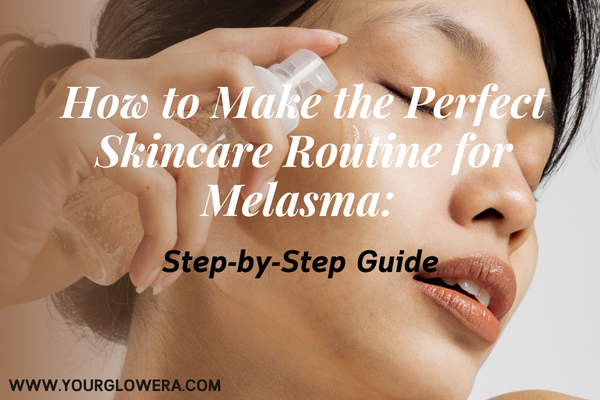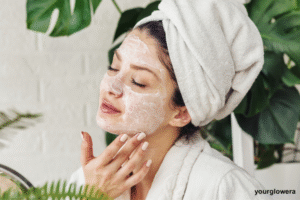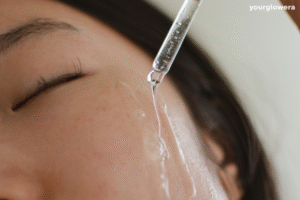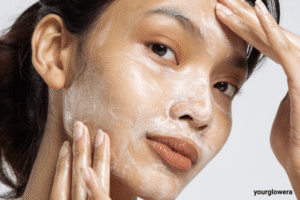Melasma is a common skin condition that causes brown or grey-brown patches, typically appearing on the face, often on the cheeks, forehead, and nose and upper lip.
While melasma is harmless, it can impact a person’s confidence, especially when these skin changes are noticeable.
In this comprehensive guide, we will take you through how to make the perfect skincare routine for melasma to help manage this condition effectively.
Along with this, we will give you with information on the best budget-friendly products that can help you achieve clear, glowing skin without breaking the bank.
Creating a skincare routine for melasma involves a blend of specific way that address the pigmentation and promote even skin tone.
The thing is to not only eliminate dark spots but also to prevent additional ones from developing.
Let’s take a deep dive into some of the best practices and products for an effective skincare routine that works to treat melasma.
Table of Contents
1. Understand the Causes of Melasma
Before we dive into skincare routine for melasma, it’s essential to understand why melasma occurs. The exact cause of melasma is not always comprehended, but it is typically linked with:
• Sun exposure: Extreme exposure to the sun triggers the overproduction of melanin( the color that gives skin its color).
• Hormonal changes: Pregnancy, birth control pills, and hormone replacement therapy can all cause melasma due to increased level of estrogen.
• Hereditary factors: If your family members have melasma, you might be susceptible to it.
Understanding these causes will help guide your skincare choices, particularly when selecting products to manage the condition.

2. Cleanse Your Skin with a Mild Cleanser
The first thing you should do in your skincare routine for melasma is wash your face.
It’s really crucial to select a gentle non-stripping cleanser that does not cause this problem for you.
Avoid cleaners with harsh chemicals, fragrances, or exfoliants, as these can increase sensitivity and pigmentation.
Recommendation: Look for a hydrating and soothing cleaner, similar as one with ceramides or glycerin, which help retain moisture without irritating the skin.
3. Exfoliate to Promote Skin Renewal
Exfoliating is an essential part of a skincare routine for melasma as it helps remove dead skin cells, promoting the regeneration of fresh skin.
Still, exfoliation must be done gently. Over-exfoliating can increase the risk of irritation and pigmentation.
• AHA (Alpha Hydroxy Acid) products, such as glycolic acid, can gently slip the face and improve skin texture.
• BHA( Beta Hydroxy Acid), like salicylic acid, can access deeper into the pores and is great for oily skin types.
Recommendation: Choose exfoliating products that are mild and suited for sensitive skin, as melasma-prone skin can be particularly reactive.
4. For Brightening, Use A Vitamin C Serum
Vitamin C is the most amazing thing you can do in the case of building a skincare routine for melasma.
It’s a powerful antioxidant that works wonders by lightening dark spots and giving your skin a brighter, more even tone.It does this by inhibiting melanin synthesis.
Plus, it helps protect your skin from free radicals that cause damage and lead to signs of aging.
Recommendation: Go for a stable form of Vitamin C, similar as ascorbic acid or sodium ascorbyl phosphate. These can be implemented directly after cleansing and before hydrating.

5. Apply a Treatment with Hydroquinone or Niacinamide
For melasma, the key ingredient that has been proven to lighten dark spots is hydroquinone.
This ingredient functions by reducing the synthesis of melanin in the skin, helping to eliminate dark spots over time.
Still, hydroquinone should be used with caution and in moderation, as excessive use can lead to skin irritation.
Alternately, Niacinamide( Vitamin B3) is a gentler option that also helps to lighten dark spots and reduce inflammation.
It’s perfect for sensitive skin and can be used both in the morning and at night.
Recommendation: Consider using a product with either hydroquinone or niacinamide in your treatment step.
6. Never Skip Sunscreen
The most important step in your skincare routine for melasma is sun protection.
Yes, melasma is mainly caused by being in the sun exposure.
Even if you are indoors or it’s cloudy outdoors, UV rays can still cause pigmentation.
It’s recommended to put on broad-spectrum SPF 30 or any advanced sunscreen every day.
Remember to reapply every two hours when you’re outdoors. Sunscreens with physical blockers like zinc oxide or titanium dioxide are often less irritating and offer effective protection as part of your skincare routine for melasma.
Recommendation: Choose a sunscreen that’s lightweight, non-comedogenic, and formulated for sensitive skin.
7. Incorporate Retinoids for Cell Turnover
Retinoids, such as retinol or tretinoin, help promote cell development and fade hyperpigmentation by accelerating the removal of old, pigmented skin cells.
Retinoids are also known to stimulate collagen production, which can improve skin texture.
At the same time, retinoids can be really powerful and can even give skin irritation in the beginning.
First of all, the lower dose should be used, and then, according to the skin’s condition, the dose can be increased gradually as part of your skincare routine for melasma.
Recommendation: Apply retinoids at night, after your treatment serum, and always follow with a moisturizing cream to help dryness.
8. Hydrate and Lock in Moisture
Melasma-prone skin can be sensitive and dry, so following the right skincare routine for melasma and ensuring proper hydration is essential.
Moisturizers with ingredients like hyaluronic acid and glycerin are great for helping your skin retain moisture while soothing any irritation caused by active ingredients.
Recommendation: Use a non-comedogenic, fragrance-free moisturizer to maintain hydration throughout the day and night.
9. Stay Consistent with Your Routine
Building an effective skincare routine for melasma requires consistency.
Results may not be visible immediately, but with continued use of the right products as part of your skincare routine for melasma, you will begin to see improvements.
Make sure to stick with your routine for at least 4 to 6 weeks before addressing its effectiveness.
10. Consult a Dermatologist for Professional Treatments
Still, it might be time to consult a dermatologist, If over-the-counter products are not giving results. Especially if you’re struggling with finding the right skincare routine for melasma .
Professional treatments like chemical peels, laser therapy, or micro-needling may help speed up the fading of melasma and improve overall skin tone.
Recommendation: Speak with a board- certified dermatologist to determine the best treatment plan according to your skin type and melasma severity.

Conclusion
Creating a skincare routine for melasma involves understanding your skin’s requirements and using the right combination of ingredients.
By following a daily routine with gentle exfoliation, effective treatments, and most importantly, sun protection, you can see visible improvements over time.
Remember to stay patient, be consistent, and consult professionals if demanded.
With the right care, melasma can be managed effectively, and your skin can regain its natural glow.
For a better way to tackle dark spots, check out our article on “The Ultimate Skincare Routine for Melasma: Tips for Clearer, Even-Toned Skin”. It goes hand in hand with the steps in this guide and gives more tips on how to manage melasma.
Sticking to a good skincare routine for melasma can help clear up your skin, and this extra routine will make the results even better. Find out more about the best skincare routine for melasma to help get rid of dark spots and even out your skin tone.
Frequently Asked Questions
How did I cure my melasma naturally?
Some people report improvement with natural remedies like aloe vera, turmeric, and vitamin C-rich foods. However, professional treatments and skincare products are more reliable.
What is the best sunscreen for melasma?
The best sunscreen for melasma is a broad-spectrum SPF of at least 30 or higher. Look for sunscreens with physical blockers like zinc oxide or titanium dioxide.
What do Koreans use for melasma?
Koreans often use products with brightening ingredients like niacinamide, arbutin, and licorice extract. They also focus heavily on sun protection.
Which moisturizer is good for melasma?
A good moisturizer for melasma should be hydrating and contain antioxidants, niacinamide, or licorice extract to brighten the skin.
What not to use with melasma?
Avoid products with strong alcohol content, aggressive exfoliants, and harsh ingredients like benzoyl peroxide, as they can irritate the skin and worsen melasma.
What procedure is best for melasma?
Chemical peels, laser treatments (like IPL or fractional lasers), and micro needling are all effective procedures for reducing melasma pigmentation.
What worsens melasma?
Sun exposure, hormonal changes, certain medications, and inflammation can worsen melasma. Always wear sunscreen and avoid triggers.
What cancels out melasma?
Using a combination of sunscreen, topical treatments (hydroquinone, vitamin C, niacinamide), and professional treatments like lasers can help reduce or cancel out melasma over time.
How can I reduce melasma fast?
Reducing melasma requires a consistent routine. Fast results can come from a combination of prescription treatments (hydroquinone, retinoids), sunscreen, and laser treatments.
Is niacinamide serum good for melasma?
Yes, niacinamide is highly beneficial for melasma. It can help reduce hyperpigmentation and even out the skin tone.









Leave a reply